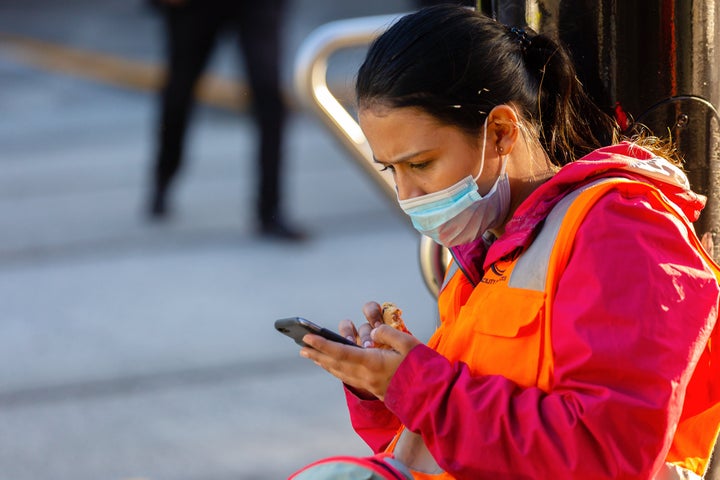
As the United States attempts to slow the spread of the coronavirus and some states begin to ease lockdown restrictions, there has been an increased focus on using contact tracing programs to prevent the number of COVID-19 cases from surging.
Contact tracing involves interviewing people who have tested positive and offering them support services. It also means identifying anyone else who has come into contact with them and letting those people know they may have been exposed to the virus. Building programs that do this effectively will take a massive mobilization of resources. Health experts estimate that the U.S. may need somewhere between 100,000 and 300,000 contact tracers, while New York state plans to hire as many as 17,000 tracers alone.
In order to help train thousands of new contact tracers, Johns Hopkins University has launched a free online course with video lessons and tests that range from the basics of coronavirus transmission to the ethics of contact tracing and communication skills for helping people who have tested positive. HuffPost spoke with Dr. Emily Gurley, an associate scientist at Johns Hopkins Bloomberg School of Public Health and the course instructor, about the challenges of contact tracing in the United States and how we can measure its effectiveness.
One thing that struck me during your course is how much more contact tracing involves than just monitoring cases and recording interactions. How do you train people on building rapport and getting contacts to trust them with their private information?
There’s definitely a training component and we try to start that in the course, giving tips on building rapport and things like active listening. There’s also a lot of training that would happen afterward once you start working with a particular health department, even more on-the-job training.
But I think that training the contact person is only one part of building trust with a public health intervention. You also have to work with the whole community and make sure people understand what you’re doing and why you’re doing it. I don’t see it as solely up to one individual contact tracer to be able to create that trust. The background trust has to be there, and what they’re doing is sort of building on that and facilitating it.
There is an increasingly politicized nature of this outbreak where some people have negative attitudes toward social distancing or public health programs. Are you worried about how that’s going to affect contact tracing programs?
Well, if people don’t trust what’s happening or understand it, then the program won’t be as successful. There is no doubt about that. I think that people who have concerns about these programs have concerns for different reasons. We really need to get at the heart of what people are uncomfortable with and why, and clarify any misinformation that they may have. I think some people really do have misinformation, and that’s part of what fuels their distrust.
I understand why people will have concerns about sharing private information with someone else. We should all wonder who wants to know this and why — that’s a valid question. But we share private information with people all the time because there’s a need to and we get something out of it. The same is true for contact tracing ― this is for a medical purpose. This is how you know when you’ve been exposed and you might be infectious, so you need to protect the people that are closest to you, the people that you love. I can’t imagine that anyone would want to unknowingly infect someone else, and this is the only way we have now to help people not do that.
I know that some people are unhappy with stay-at-home orders or social distancing because of the economic consequences. Contact tracing is a program that can help us get back to a life that looks more normal. This is helping us to do that without huge increases in cases and deaths. Nobody wants to see that. This is our best chance at reducing the risk as much as we can while trying to restart our lives.
There’s this huge effort right now to train and scale up the number of contact tracers. What do we need in place to monitor these programs and gauge whether we’re doing a good job? How do we know that this is working?
So just training a bunch of people to do contact tracing and hiring them is not enough to get the job done. We have to be monitoring indicators of the contact tracing system. There are very good ways to do this, it’s just basic data analysis. Looking at the proportion of people that you’re able to find or when are you able to quarantine contacts, for example. What proportion of contacts are you able to trace, and how quickly do you find cases after their onset of symptoms? All these different timelines can be measured to see how effective the program is.
Systems should be looking at how to improve those timelines and how to make those programs more effective, but I think there’s often a misconception that this is an all-or-nothing thing ― well, we have too many cases so we can’t do contact tracing ― which is not true. You may not be able to really make a difference if you don’t have enough contact tracers, you may not be able to stop the spread, but you’re still reducing the size of the outbreak. What we’re trying to do with this, ideally, is to keep transmission level so that you don’t have a big increase in cases.
I guess there’s a misconception that if we trace enough people, we can outright stop this — but that’s just not the case?
That’s not the case at all, but any contact tracing you do is going to have some effect. At the end of the day, anything you do is going to have an effect, but is it going to be good enough to keep transmission steady and keep it from going out of control? When you open up society, you’re giving the virus new opportunities. You have to be really good at shutting those opportunities down or you’re going to see more cases.
Are there things about the U.S. outbreak that present unique challenges for contact tracing? Other nations have centralized health care systems to log cases and information, for instance.
Absolutely. People talk a lot about South Korea and contact tracing there. It was very fast and efficient, but they do things that we don’t do. They have one ID for each person and that ID is used to register your phone, it’s used for all your medical records. It’s one ID that’s linked to a government system, and at any given time they can see you’ve tested positive and these are all the GPS points from your phone. They can notify everybody immediately and all that is in one system, all linked up. We don’t have that, and we will never have that.
In the United States, even just getting a test and then getting test results back into one database that’s reported to a state or city can be quite onerous. There are many different steps along the way, and it just means that we’re at a disadvantage from that perspective because it’s slower.
Is there a worry that the U.S. just won’t reach the necessary timely testing levels to work successfully in conjunction with contact tracing?
It’s not an all-or-nothing. The U.S. is already doing contact tracing and they’re already stopping infections. The question is: Are they doing it enough, and are they doing it quickly enough to be able to keep disease transmission level? That’s the question. Without knowing the metrics of how the systems are functioning, without really getting into the weeds about the details in any particular city or state, it’s hard to know that.
This interview has been edited and condensed for clarity.
- Stay up to date with our live blog as we cover the COVID-19 pandemic
- 7 essential pieces of relationship advice for couples in quarantine
- What you need to know about face masks right now
- How to tell if you need to start doing online therapy
- Lost your job due to coronavirus? Here’s what you need to know.
- Parenting during the coronavirus crisis?
- The HuffPost guide to working from home
- What coronavirus questions are on your mind right now? We want to help you find answers.
- Everyone deserves accurate information about COVID-19. Support journalism without a paywall — and keep it free for everyone — by becoming a HuffPost member today.
